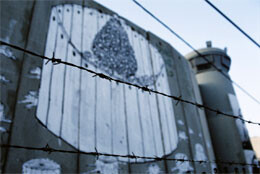The Electronic Intifada 1 January 2008

Israel’s wall in Bethlehem. (Shabtai Gold/IRIN)
“I worked in Israel for over 15 years,” Muhammed, aged 44, registered with UNRWA, the UN agency for Palestinian refugees, told IRIN. “It’s been two years now since I lost my permit. At first I snuck into Israel through valleys and other illegal ways, but now, with the wall completed, I can’t get in at all.”
All Palestinians from the occupied Palestinian territory require an Israeli-issued permit to enter Israel.
Israel credits the barrier for the cessation of suicide bombings, while officials note that some of the last bombers came from Bethlehem. Palestinians say the wall and fence structure “strangles” the city.
Unemployment compounded by travel restrictions
“When I worked in Israel, I was making close to a US$1,000 a month,” Muhammed said. Now, he does odd construction jobs in the camp. “I don’t make enough money like this. We only buy the essential things for the home.”
Without his wife’s salary as a teacher, they would not be able to afford even the basics.
That is the case of Harbi, aged 41, also a refugee. His wife does not have a job and he has not been able to get work in Israel for the last eight months: “My problem is that I am an unskilled laborer, so there are no jobs for me in the West Bank,” he told IRIN.
Unemployment is a widespread problem in the territory. Israel’s internal West Bank checkpoints also mean traveling is difficult, affecting a worker’s ability to take a job in another city.
“My brothers give me money for food and clothing. I have no [independent] income at all. I got one food aid package this year from the UN,” said the father of five. His youngest daughter, aged two, has asthma. While UNRWA covered 80 percent of the medicines’ costs, he had to ask his brothers for the rest.
“Without my brothers, I don’t know what I would do,” Harbi said.
The need for permits began in 1991, during the first Gulf War following Iraq’s invasion of Kuwait and the first intifada (Palestinian uprising against Israeli occupation). The restrictions became tighter several years later, following the Oslo Accords, and were further intensified at the start of the second uprising in September 2000. The wall, completed in the Bethlehem region in recent years, sealed the area off from neighboring Jerusalem.
Day in the life of a laborer
“I wake up every day at 2:30am,” Adnan, a 41-year-old laborer, told IRIN. “By 3am, I leave the house and 10 minutes later I’m at the checkpoint. I wait at the checkpoint until maybe 5:30 or 5:45am, when they open it.”
The checkpoint lies over the Green Line and separates Jerusalem from Bethlehem and serves as a focal point in the barrier.
“I have to come so early, because many people wait to work inside [Israel], and if you don’t come early, you may not make it in. By 7am I have to be at the meeting point by [Jerusalem’s] old city to be picked up and taken to work,” the bearded man said.
“Sometimes, when there are problems or delays at the checkpoints, or there are flying checkpoints in Jerusalem, I miss work.”
He works, on average, about three days a week. He said the costs involved in travel, combined with problems in receiving his full wages, have made work in Israel less lucrative than in the past.
“If I could find a job in Bethlehem, I wouldn’t go through the hardship of the checkpoint,” he said. “I get home at 6pm, eat and sleep: from work to the mattress to work.”
Adnan’s parents came from Beit Natif village, until they fled during the 1948 War. Ironically, he now works building homes in Beit Shemesh, an Israeli city founded partially on his family’s village.
This item comes to you via IRIN, a UN humanitarian news and information service, but may not necessarily reflect the views of the United Nations or its agencies. All IRIN material may be reposted or reprinted free-of-charge; refer to the copyright page for conditions of use. IRIN is a project of the UN Office for the Coordination of Humanitarian Affairs.
Related Links